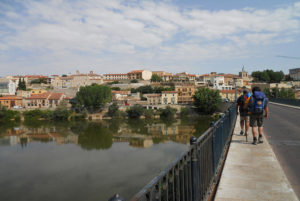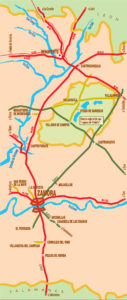Silver Route

 The line drawn by the old Roman road from Mérida to Astorga runs alongside what has been long known as the ‘Vía de la Plata’ or The Silver Route. The Silver Route crosses Zamora province from south to north – a route that was also once an itinerary for the ‘Cañadas Reales’ (‘royal drovers’ rights of way).
The line drawn by the old Roman road from Mérida to Astorga runs alongside what has been long known as the ‘Vía de la Plata’ or The Silver Route. The Silver Route crosses Zamora province from south to north – a route that was also once an itinerary for the ‘Cañadas Reales’ (‘royal drovers’ rights of way).
VISITS
- El Perdigón: 10km away from Zamora, its underground wine cellars are famous and visitors can taste wine and local products here.
- Zamora: Historical site. More than twenty Romanesque churches are spread around the town, mixing with a range of eclectic and historicist buildings that have allowed Zamora to become a member of the exclusive group of towns that are part of the Art Nouveau European Route. As for contemporary architecture, the town has a range of important buildings that have earned it international recognition and contributed to enriching the town’s heritage, without forgetting Zamora’s internationally renowned Easter celebrations.
- Castrotorafe: The ruins of the 12th-century fortress. The remains of the town and castle are also visible.
- Monasterio de Santa María de Moreruela. This beautiful monastic complex is home to one of province’s loveliest examples of the Romanesque style, seen in the apse and seven apse chapels. Built at the end of the 12th century.
- The municipal districts of Villafáfila, Villarrín de Campos and Otero de Sariegos are home to the ‘Lagunas de Villafáfila’ Regional Hunting Reserve, a group of lakes where thousands of migrating birds spend the winter.
- Villalpando. This old Templar town still maintains the ruins of its 12th-century wall in the gates of San Andrés and Santiago. It is famous for its sweet products,known as ‘feos’.
- Benavente. This past and present strategic point and crossroads marks the end of The Silver Way in Zamora and provides the visitor with a range of emblematic monuments, such as the Torre del Caracol tower and the Romanesque churches of San Juan del Mercado and Santa María del Azogue, from the 12th and 13th centuries.The valleys’ fields have made the region’s red peppers famous, while the wine of the lowlands has been awarded D.O. status. Bullfighting is also important here, in an event known as ‘Toro Enmaromado’ (in which a bull is released onto the town’s streets guided by a rope).
